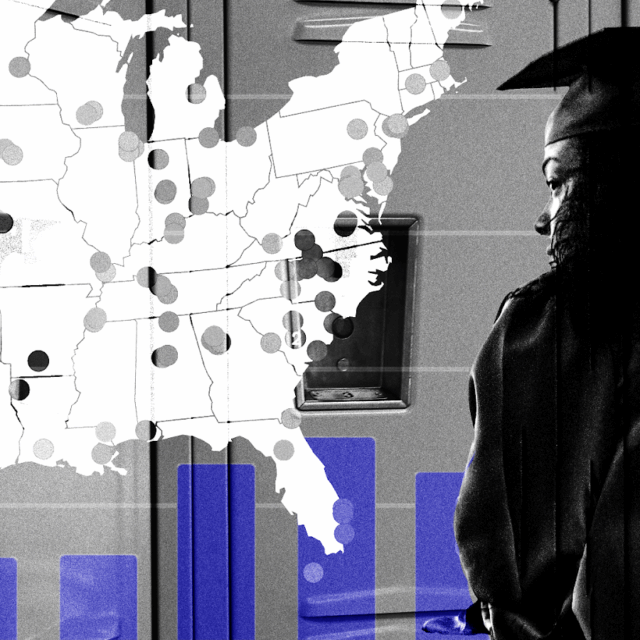Freedom from Fear of Hate-Fueled Violence: Preventing Transgender Homicides
3.12.2024
Every year without exception, over two dozen transgender people are killed. Nearly three in four of these homicides are committed with a gun. In order to better understand the link between gun violence and violence against the transgender community, and to raise awareness of hate crimes motivated by a victim’s gender identity, Everytown began tracking these acts of violence in 2017.
The statistics make it clear: violence against transgender people is a gun violence issue. In 2023 alone, there were 35 homicides of transgender and gender-expansive people in the US and Puerto Rico and guns were used in 80 percent of these deadly acts.1 Everytown for Gun Safety Support Fund, Transgender Homicide Tracker, 2023.
In 2023, 80 percent of homicides of transgender people were with a gun.
From January 2017 to December 2023, there were at least 263 homicides of transgender people in the United States, 193 of which were with a gun.2Everytown for Gun Safety Support Fund, Transgender Homicide Tracker, 2017–2023. Further, these tragedies have a gravely disproportionate impact. More than six in 10 gun homicides of transgender and gender-expansive people were of Black trans women, and one in 10 were of trans Latinas.3Everytown for Gun Safety Support Fund, Transgender Homicide Tracker, 2017–2023. Download the data here.
There are over two dozen transgender homicides every year.
| Year | Number of homicides of transgender people |
|---|---|
| 2017 | 30 |
| 2018 | 26 |
| 2019 | 28 |
| 2020 | 44 |
| 2021 | 59 |
| 2022 | 41 |
| 2023 | 35 |
Some trends observed in homicides of transgender individuals mirror patterns seen in gun violence generally, particularly as it relates to the toll on young people and involvement of domestic violence. Violence against younger members of the transgender community—59 percent of victims of trans gun homicides being under the age of 304 Everytown for Gun Safety Support Fund, Transgender Homicide Tracker, 2017–2023.—comes as no surprise in a country where guns are the leading killer of children, teens, and college-aged people.5Centers for Disease Control and Prevention, National Center for Health Statistics. WONDER Online Database, Underlying Cause of Death, Injury Mechanism & All Other Leading Causes. Data from 2021. Children and teens defined as 1 to 17, and college-aged defined as 18 to 25. At least 20 percent of violent deaths among trans people stem from intimate partner or family violence and the great majority (69 percent) of these deaths are with a gun.6 Everytown for Gun Safety Support Fund, Transgender Homicide Tracker, 2017–2023. This tracks with the role guns play in intimate partner violence more broadly: more than seven in 10 of all intimate partner homicides in the United States are committed with a gun.7 Everytown Research analysis of Centers for Disease Control and Prevention, National Violent Death Reporting System (NVDRS), 2021. Ages: 18–85+.
On the other hand, this violence is not evenly spread across our country. It occurs at a time when state governments are considering and passing laws that target transgender people: banning access to bathrooms, limiting access to gender-affirming health care, or curtailing trans kids’ ability to participate in sports.8Human Rights Campaign, “New HRC State Equality Index Shows Devastating Impact of Radical Anti-LGBTQ+ 2023 State Legislative Season,” press release, January 30, 2024, https://www.hrc.org/press-releases/new-hrc-state-equality-index-shows-devastating-impact-of-radical-anti-lgbtq-2023-state-legislative-season; UCLA School of Law, Williams Institute, “Nearly 100,000 Transgender Touth Live in States That Banned Access to Health Care, Sports, or School Bathrooms in 2023,” press release, October 19, 2023, https://williamsinstitute.law.ucla.edu/press/trans-leg-summary-press-release/. These deliberations and actions have had lethal consequences. Forty-five percent of gun homicides of transgender and gender-expansive people since 2017 took place in the South,9 Everytown for Gun Safety Support Fund, Transgender Homicide Tracker, 2017–2023. states that make up only 38 percent of the total US population.10Everytown for Gun Safety analysis of American Community Survey, 2017-2022, over this time the total population of the United States was 1,955,997,614. 743,261,965 or 38% (743,261,965/1,955,997,617) lived in the Southern Census Region. A recent large survey by the National Center for Trans Equality showed that 5 percent of respondents moved to another state because their state government considered or passed laws that target transgender people. The top 10 states from which respondents moved because of these laws were Alabama, Arizona, Florida, Georgia, Missouri, North Carolina, Ohio, Tennessee, Texas, and Virginia.11 Sandy E. James et al., “Early Insights: A Report of the 2022 U.S. Transgender Survey,” National Center for Transgender Equality, February 2024, https://transequality.org/sites/default/files/2024-02/2022%20USTS%20Early%20Insights%20Report_FINAL.pdf. Seven of these states are ranked as having “weak systems” or are categorized as “national failures” in terms of the strength of 50 key gun safety laws in Everytown’s 2024 Gun Law Rankings.
Gun safety policies save lives. In an average year, more than 25,000 hate crimes in the United States involve a firearm—69 per day. Federal law bars people with felony convictions from having guns. But many hate crimes are classified as misdemeanors. Therefore under federal law, many people who commit violent acts and are convicted of hate crimes may still be legally armed. As of 2023, half of US states prohibit these individuals from having guns, either by making their convictions into felonies or by extending state gun laws to reach hate crimes. But states that have no hate crime prohibitor laws are also states where trans homicides cluster. Texas, which had the largest death toll of trans people of any state over our study period (27 homicides) doesn’t prohibit people with misdemeanor hate crime convictions from having firearms.
There is a pressing need for action on two fronts: gun safety legislation proven to save lives and the rejection of transphobic legislation. The connection between legislative hostility towards the LGBTQ+ community and risks of violence faced by transgender individuals is clear and deeply troubling. Discriminatory laws perpetuate systemic inequalities, exacerbating the vulnerability of marginalized groups to violence and discrimination. Policymakers have a responsibility to foster an environment of respect and safety for all individuals, including trans and gender-expansive people. Hateful actions in our communities, no matter who they are against, affect all of us. By challenging transphobic rhetoric and legislation and promoting gun safety policy, we will all live in communities freer from fear of hate-fueled violence.




